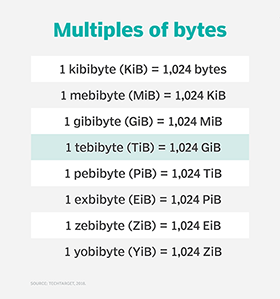tebibyte (TiB)
What is a tebibyte (TiB)?
A tebibyte (TiB) is a unit of measure used to describe computing capacity. The prefix tebi comes from the binary system for measuring data capacity. That system is based on powers of two. One tebibyte equals 240 or 1,099,511,627,776 bytes.
The International Electrotechnical Commission (IEC) created the term tebibyte and the other binary prefixes -- kibi, mebi, gibi, pebi, exbi, zebi and yobi -- in 1998. In the early days of computing, before the binary prefixes were created, the metric prefixes in the International System of Units (SI) referred to both the power-of-10 multipliers in the decimal system of measurement and the binary system's power-of-two multipliers. The SI prefixes include kilo, mega, giga, tera, peta, exa, zetta and yotta. Today they are referred to as the decimal system of prefixes.
When the SI prefixes were used to refer to both multiplier systems, context was the only way to determine which system was being referred to when the term terabyte (TB) was used. That term could refer to either 1012 (1,000,000,000,000) bytes or 240 (1,099,511,627,776) bytes.
That changed in 1998 when the IEC created the binary prefixes. Since then, the system people use often depends on the discipline or industry they are in. The communications, electronics and physics sectors are more likely to use the decimal system's power-of-10 metric units. The IT and data storage industries often use the binary system's power-of-two nonmetric units.
What tebibytes are used for
In the computer industry's early years, it wasn't a problem to use the same system of prefixes to refer to both the power-of-10 and the power-of-two multipliers. Data storage capacities then were much smaller than what they are today. At the low end of the multiplier scale, the difference in the absolute values of the numbers the two systems generated was relatively small.
For example, there are 1,000 bytes in a kilobyte (KB) of data using the power-of-10 system. Using the power-of-two definition, a kilobyte of data equals 1,024 bytes. That 24-byte difference was often considered negligible. However, as the scale of computing and data storage capacity has grown, the absolute difference between measurements using the two systems has been magnified.
A terabyte of data using the decimal, power-of-10 system equals 1,000,000,000,000 bytes, while a terabyte of data using the binary, power-of-two system would equal 1,099,511,627,776 bytes. The nearly 100 billion-byte difference began to cause problems and could not be ignored.
By the latter half of the 1990s, using the same prefixes for two different units of measure had become confusing. A common problem happened because disk drive manufacturers used the decimal system when labeling the capacity of HDDs and SSDs. But operating system (OS) vendors preferred to use the binary power-of-two system to measure computer memory and data storage capacity. When a customer bought a new HDD that the manufacturer labeled as having 1 TB of capacity, the computer OS would report that it had only 931.32 gigabytes (GB) of capacity.
The IEC standard for the binary system of measurement was developed to eliminate this confusion. If, in the example above, the OS had used the binary system of prefixes instead of the decimal system, it would have reported 931.32 gibibytes (GiB) instead of 931.32 GB of capacity. The consumer would also be alerted that the OS vendor was using a different system of measurement than the HDD manufacturer.
The creation of the binary prefix system didn't solve the capacity measurement problem, however. In practice, those prefixes are mostly used in academic circles, technical writing and open system environments. Commercial vendors and IT professionals tend to not use the binary prefixes.

How large is a tebibyte?
A tebibyte is larger than the following binary data capacity measures:
- A byte. A TiB is equal to 1,099,511,627,776 bytes.
- A kibibyte. A TiB is equal to 1,073,741,824 KiB.
- A mebibyte. A TiB is equal to 1,048,576 MiB.
- A gibibyte. A TiB is equal to 1,024 GiB.
Binary data capacity measures that are larger than a tebibyte include the following:
- A pebibyte (PiB) is 1,024 times the size of a TiB.
- An exbibyte (EiB) is 1,048,576 times the size of a TiB.
- A zebibyte (ZiB) is 1,073,741,824 times the size of a TiB.
A 1 TiB HDD would hold nearly 1.1 trillion bytes of data. Here are some other ways to visualize 1 TiB of data:
- 79 hours of broadcast-quality video.
- Nearly 143,000 digital photos.
- 165 hours of high-definition recording.
- 2,199 hours of CD-quality recording.

Converting tebibytes to gibibytes
A tebibyte equals 1,024 GiB. To do the conversion, take the 1,099,511,627,776 bytes that make up a tebibyte, and divide that number by the number of bytes in a gibibyte, or 1,073,741,824. That gives you 1,024 GiB.
In the binary system, each successively higher prefix has 210, or 1,024, times the number of bytes of the next lower prefix. A tebibyte is 1,024 times the number of bytes in a gibibyte. A pebibyte is 1,024 times the number of bytes in a tebibyte. An exbibyte is 1,024 times the number of bytes in a pebibyte and so on.
Tebibyte vs. terabyte
One tebibyte is equal to 240 or 1,099,511,627,776 bytes. One terabyte is equal to 1012 or 1,000,000,000,000 bytes. A tebibyte equals nearly 1.1 TB. That's about a 10% difference between the size of a tebibyte and a terabyte, which is significant when talking about storage capacity.
At the lower end of the capacity spectrum, when you talk about a kibibyte vs. a kilobyte or a mebibyte vs. a megabyte, the difference between binary units of measure and the decimal units of measure is nearly negligible. However, with tebibytes vs. terabytes, the difference between the two systems matters.
Editor's note: This article was revised in 2023 by TechTarget editors to improve the reader experience.








